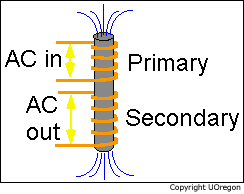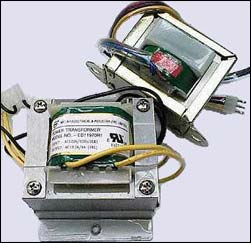Solar Micro Car Kit DIY STEM Kit
$9.99$5.55
 The construction of a transformer includes a ferromagnetic core around which multiple coils, or windings, of wire are wrapped. The input line connects to the 'primary' coil, while the output lines connect to 'secondary' coils. The alternating current in the primary coil induces an alternating magnetic flux that 'flows' around the ferromagnetic core, changing direction during each electrical cycle. The alternating flux in the core in turn induces an alternating current in each of the secondary coils. The voltage at each of the secondary coils is directly related to the primary voltage by the turns ratio, or the number of turns in the primary coil divided by the number turns in the secondary coil. For instance, if the primary coil consists of 100 turns and carries 480 volts and a secondary coil consists of 25 turns, the secondary voltage is then:
The construction of a transformer includes a ferromagnetic core around which multiple coils, or windings, of wire are wrapped. The input line connects to the 'primary' coil, while the output lines connect to 'secondary' coils. The alternating current in the primary coil induces an alternating magnetic flux that 'flows' around the ferromagnetic core, changing direction during each electrical cycle. The alternating flux in the core in turn induces an alternating current in each of the secondary coils. The voltage at each of the secondary coils is directly related to the primary voltage by the turns ratio, or the number of turns in the primary coil divided by the number turns in the secondary coil. For instance, if the primary coil consists of 100 turns and carries 480 volts and a secondary coil consists of 25 turns, the secondary voltage is then:
 A transformer may have multiple secondary coils to feed a number of electrical loads; however, power must be conserved, so the sum of the output power must equal the sum of the input power minus losses. Energy losses in transformers are due to a number of factors: these are copper losses in the coils themselves due to material resistance, core losses due to hysteresis (the reluctance of the material's magnetic domains to reverse during each electrical cycle), and eddy currents.
A transformer may have multiple secondary coils to feed a number of electrical loads; however, power must be conserved, so the sum of the output power must equal the sum of the input power minus losses. Energy losses in transformers are due to a number of factors: these are copper losses in the coils themselves due to material resistance, core losses due to hysteresis (the reluctance of the material's magnetic domains to reverse during each electrical cycle), and eddy currents.
 'A theory with mathematical beauty is more likely to be correct than an ugly one that fits some experimental data. God is a mathematician of a very high order, and He used very advanced mathematics in constructing the universe.'
'A theory with mathematical beauty is more likely to be correct than an ugly one that fits some experimental data. God is a mathematician of a very high order, and He used very advanced mathematics in constructing the universe.'